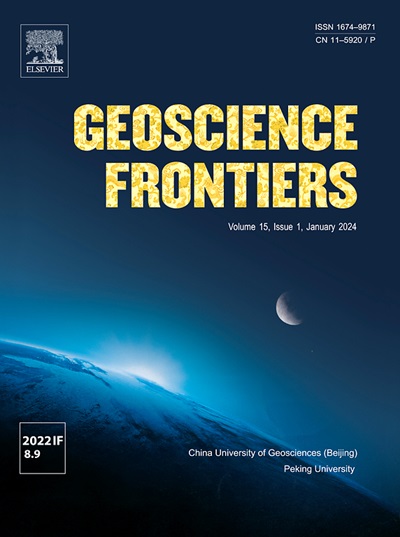造山带岩石圈碳循环机制:锂同位素视角
IF 8.9
1区 地球科学
Q1 GEOSCIENCES, MULTIDISCIPLINARY
引用次数: 0
摘要
俯冲板块通过底渗作用、变质脱碳、碳酸盐溶解和分型熔融等多种机制将碳输送到地幔深处,并释放到上覆的地幔楔和岩石圈地幔中。确定次大陆岩石圈地幔(SCLM)碳酸化的主要碳循环机制仍然具有挑战性,但它对于理解碰撞后碳酸盐岩和相关稀土元素矿床的成因至关重要。为了解决这一问题,我们研究了西藏东南部冕宁-德昌地区典型的碰撞后碳酸盐岩-碱性杂岩的Li同位素系统。结果表明,演化程度较低的岩浆(煌斑岩)δ7Li值与地幔相似或略低(0.3‰~ 3.6‰),变异性有限,与伴生碳酸岩和正长岩的δ7Li范围较宽形成鲜明对比。我们将这种二元分类解释为反映了不同的过程:虽然分异岩石(碳酸盐岩和正长岩)的δ7Li值变化和异常是由晚期岩浆-热液作用(包括黑云母分馏、流体溶蚀和热液蚀变)引起的,但煌斑岩保留了其地幔源的原始Li同位素特征。这种地幔状或略低的δ7Li值,以及其弧形微量元素和em1 - em2型Sr-Nd-Pb同位素特征,阻止了高δ7Li储层(蚀变洋壳、蛇纹岩)的碳衍生和沉积碳通过变质脱碳或溶蚀作用的再循环。相反,这些特征表明碳主要是通过俯冲含碳酸盐沉积物的部分熔融而进入地幔源的。该研究表明,Li同位素可以作为识别碰撞带碳循环机制的示踪剂。本文章由计算机程序翻译,如有差异,请以英文原文为准。

The mechanism of carbon recycling into orogenic lithosphere: A Li isotope perspective
Subducting slabs transport carbon to deep mantle depths and release it into the overlying mantle wedge and lithospheric mantle through multiple mechanisms, including mechanical removal via diapirism, metamorphic decarbonization, carbonate dissolution and parting melting. Identifying the dominant carbon recycling mechanism responsible for carbonation of subcontinental lithospheric mantle (SCLM) remains challenging, yet it is critical for understanding the genesis of post-collisional carbonatites and associated rare earth element deposits. To address this issue, we investigate the Li isotopic systematics of typical post-collisional carbonatite-alkalic complexes from Mianning-Dechang (MD), Southeast Tibet. Our results show that the less-evolved magmas (lamprophyres) have mantle-like or slightly lower δ7Li values (0.3‰–3.6‰) with limited variability, contrasting sharply with the wider δ7Li range observed in associated carbonatites and syenites. We interpret this dichotomy as reflecting distinct processes: while the variable and anomalous δ7Li values in differentiated rocks (carbonatites and syenites) were caused by late-stage magmatic-hydrothermal processes (including biotite fractionation, fluid exsolution and hydrothermal alteration), the lamprophyres retain the primary Li isotopic signature of their mantle source. Together with their arc-like trace element and EM1-EM2-type Sr-Nd-Pb isotopic signatures, such mantle-like or slightly lower δ7Li values of the lamprophyres preclude carbon derivation from high-δ7Li reservoirs (altered oceanic crust, serpentinites) and recycling of sedimentary carbon through metamorphic decarbonization or dissolution. Instead, these features indicate that the carbon was predominantly transported into the mantle source via partial melting of subducted carbonate-bearing sediments. This study demonstrates that Li isotopes can serve as a tracer for identifying the mechanism of carbon recycling in collision zones.
求助全文
通过发布文献求助,成功后即可免费获取论文全文。
去求助
来源期刊

Geoscience frontiers
Earth and Planetary Sciences-General Earth and Planetary Sciences
CiteScore
17.80
自引率
3.40%
发文量
147
审稿时长
35 days
期刊介绍:
Geoscience Frontiers (GSF) is the Journal of China University of Geosciences (Beijing) and Peking University. It publishes peer-reviewed research articles and reviews in interdisciplinary fields of Earth and Planetary Sciences. GSF covers various research areas including petrology and geochemistry, lithospheric architecture and mantle dynamics, global tectonics, economic geology and fuel exploration, geophysics, stratigraphy and paleontology, environmental and engineering geology, astrogeology, and the nexus of resources-energy-emissions-climate under Sustainable Development Goals. The journal aims to bridge innovative, provocative, and challenging concepts and models in these fields, providing insights on correlations and evolution.
 求助内容:
求助内容: 应助结果提醒方式:
应助结果提醒方式:


